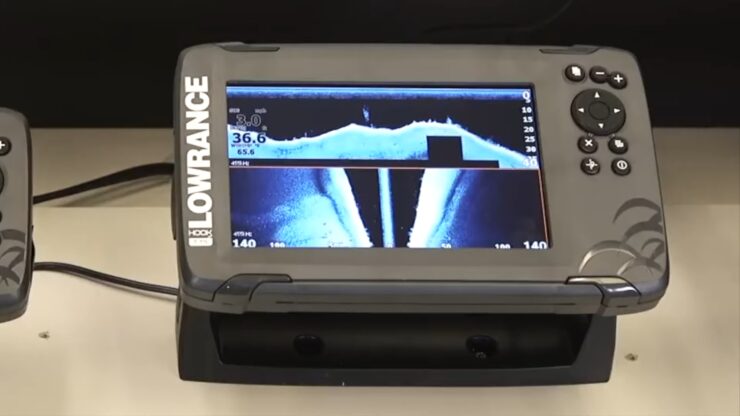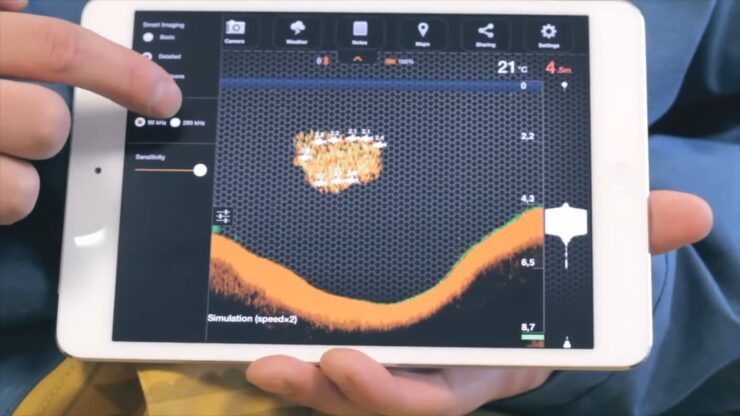Humans have made unprecedented growth in technology and innovation. These inventions have not only lead to a more comfortable life, but it has also broadened the horizon in all spheres of life. One of the inventions includes a fish finder. A fish finder is a device that is used to locate fish underwater. It uses the principle of Sonar to locate fish underwater.
These devices are used not only in sports but also commercially. Modern fish finders employ different tools and concepts such as GPS, Sonar, and digital display. The interpretation of information collected through a fish finder provides information about underwater fish and underlying debris. These instruments have been derived from Fathometers.
Read More: How To Cast A Fishing Rod? – A Complete Guide
Table of Contents
ToggleTypes of Fish Finders

There are different types of fish finders. There are ones that use colored screens and others use black and white screens and are called grey scales. Frequencies used by fish finders are also different ranging from higher frequency to lower frequency.
A fish finder that uses a higher frequency has more wave cycles per minute that enhance its ability to locate the smallest fish in shallow depth. Further, they are also classified based on the type of data they depict. Some latest fish finders depict identifiable objects as fish, while conventional fish finders present it in the form of lines and arches. These are a bit complex than the latest ones.
Composition and parts of a Fish Finder
A fish finder constitutes of two main parts, a Transducer, and a Screen to depict the result. The screen may be black and white or colored. Sonar waves are emitted from the transducer or from the bottom part of the fish finder that is placed inside the water attached to a fishing Kayak or boat. These waves are reflected and come back to the transducer.
The transducer uses this data to record speed and the distance at which they come back.
Visual Display of Fish Finder and Information Matrix:

The transducer collects the data and depicts it visually. The fish finder using sonar tells about the depth of water, which provides information about the type of fish in the surrounding water. This information is usually provided on the top left of the fish finder screen.
Often the depth is provided in meters than in feet. However, the accuracy of calculated depth varies from model to model of the fish finder. The temperature reading generally mentioned below the depth reading. This information is particularly useful for people who are in search of fish that live in a specific environmental condition. For example, some fish live in warm water while others live in a colder environment.
Another, important feature that fish finders have is the ability to measure the speed with which you are moving. It calculates this through a speed sensor. In order to understand the results of visual depiction on color as well as greyscale fish finders, we need to understand how to interpret the information provided on the screen of the fish finder.
The color is directly proportional to the density and hardness of the object from which the waves were reflected. The greater the intensity of the reflected echo, the darker the color will appear. Since the bed of the water contains the densest objects so it appears darkest. It may also appear as a thick or thin borderline. If the line is light it means that the bed of water is either clay or something less dense. However, a thick darker line depicts that the bed is dense and hard.
How to know which species of Fish is under the water through Fish Finder?
This data is also very important to identify what type of fish to expect. It provides very valuable information for those who search for specific fish. Fish like Tuna live in a different habitat while fish like Salmon lives in a totally different environment.
So the composition of the bed, the density, and harness of the bed, temperature of the water provide valuable information about what kind of fish to expect and also their quantity. It is also important to know how fish and other objects appear on the fish finder. this information interpretation is very important to identify and locate fish underwater.
Read More: Fishing Tips For Beginners – A Detailed Smart Guide!
Interpretation of Fish Finder Screen Visuals:
1. Fish-ID Technology
There are two types of data. Some of the latest fish finders interpret the lines as identifiable objects, while others present the data in raw form. These fish finders use a technology called Fish-ID.
This technology is the advanced version of fish finders. This technology converts raw data into a much simpler visual depiction. The size of the object depends on the size of the detected fish.
The size of small fish is presented by a small object, while that of bigger fish is depicted by bigger objects. The latest fish finders have the ability to identify and differentiate between fish and other substances such as rocks and plants. The screen of the fish finder gives the information through visual depiction and makes it easier for the user to identify and locate fish underwater.
2. Conventional Technology
The other type of fish finder does not present big data in visual objects but it is presented as raw data In the form of lines and arches. This data is used to identify stagnant and moving objects. The stagnant objects are depicted by lines while moving objects are depicted as arches. The size of the arch varies with the size of the fish.
The arch of bigger fish appears as a large arch while that of smaller fish appears as a smaller arch. It’s a bit tricky to identify plants and other stuff but once you get used to it. It becomes easier to use.
Cost Analysis Fish finders prices range from low cost to highly innovative but costly products. Though it’s accurate it has certain limitations. It is only as useful as the user’s ability to use it. Thus understanding the working of fish finders and the ability to interpret the information provided by them is pivotal for its benefit.
Recommended video guide on how to read a fish finder:
Conclusion
These devices are used not only in sports but also commercially. Modern fish finders employ different tools and concepts such as GPS, Sonar, and digital display. The interpretation of information collected through a fish finder provides information about underwater fish and underlying debris.
It is particularly useful as it does not only save time but it is cost-effective and efficient. It helps identify fish underwater. Thus, it helps in specific searching techniques.
Hey there! I’m Oliver Adler, the kayak-paddling, fish-catching enthusiast. My love for the water started with a childhood spent by the sea, and it’s grown into a lifelong passion for everything from kayaking to kite surfing, and yes, even fishing.
Related Posts:
- 10 Best Fish Finders Under $200 2024 - Top Affordable Picks
- Heavy Duty Fishing: 11 Best Rods And Reels For Big Fish 2024
- 12 Best Kayak GPS 2024 - Find Your Way to Adventure
- 10 Best Fish Finders For Kayak 2024 - Catch More…
- 17 Best Trolling Reels 2024 - Enjoy your Fishing Adventure
- 12 Best Fishing Lures Ever 2024 - Baits That…












